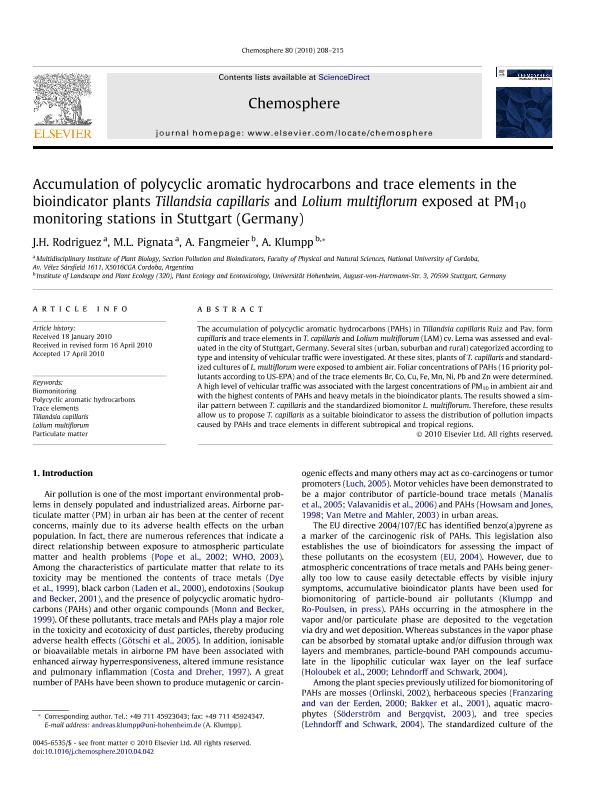Mostrar el registro sencillo del ítem
dc.contributor.author
Rodriguez, Judith Hebelen

dc.contributor.author
Pignata, María Luisa
dc.contributor.author
Fangmeier, A.
dc.contributor.author
Klumpp, A.
dc.date.available
2017-05-04T18:23:04Z
dc.date.issued
2010-06
dc.identifier.citation
Rodriguez, Judith Hebelen; Pignata, María Luisa; Fangmeier, A.; Klumpp, A.; Accumulation of polycyclic aromatic hydrocarbons and trace elements in the bioindicator plants Tillandsia capillaris and Lolium multiflorum exposed at PM10 monitoring stations in Stuttgart (Germany); Elsevier; Chemosphere; 80; 3; 6-2010; 208-215
dc.identifier.issn
0045-6535
dc.identifier.uri
http://hdl.handle.net/11336/15987
dc.description.abstract
The accumulation of polycyclic aromatic hydrocarbons (PAHs) in Tillandsia capillaris Ruiz and Pav. form capillaris and trace elements in T. capillaris and Lolium multiflorum (LAM) cv. Lema was assessed and evaluated in the city of Stuttgart, Germany. Several sites (urban, suburban and rural) categorized according to type and intensity of vehicular traffic were investigated. At these sites, plants of T. capillaris and standardized cultures of L. multiflorum were exposed to ambient air. Foliar concentrations of PAHs (16 priority pollutants according to US-EPA) and of the trace elements Br, Co, Cu, Fe, Mn, Ni, Pb and Zn were determined. A high level of vehicular traffic was associated with the largest concentrations of PM10 in ambient air and with the highest contents of PAHs and heavy metals in the bioindicator plants. The results showed a similar pattern between T. capillaris and the standardized biomonitor L. multiflorum. Therefore, these results allow us to propose T. capillaris as a suitable bioindicator to assess the distribution of pollution impacts caused by PAHs and trace elements in different subtropical and tropical regions.
dc.format
application/pdf
dc.language.iso
eng
dc.publisher
Elsevier

dc.rights
info:eu-repo/semantics/openAccess
dc.rights.uri
https://creativecommons.org/licenses/by-nc-nd/2.5/ar/
dc.subject
Biomonitoring
dc.subject
Polycyclic Aromatic Hycrocarbons
dc.subject
Trace Elements
dc.subject
Tillandsia Capillaris
dc.subject
Lolium Multiflorum
dc.subject
Particulate Matter
dc.subject.classification
Otros Tópicos Biológicos

dc.subject.classification
Ciencias Biológicas

dc.subject.classification
CIENCIAS NATURALES Y EXACTAS

dc.title
Accumulation of polycyclic aromatic hydrocarbons and trace elements in the bioindicator plants Tillandsia capillaris and Lolium multiflorum exposed at PM10 monitoring stations in Stuttgart (Germany)
dc.type
info:eu-repo/semantics/article
dc.type
info:ar-repo/semantics/artículo
dc.type
info:eu-repo/semantics/publishedVersion
dc.date.updated
2017-04-26T18:38:56Z
dc.journal.volume
80
dc.journal.number
3
dc.journal.pagination
208-215
dc.journal.pais
Países Bajos

dc.journal.ciudad
Amsterdam
dc.description.fil
Fil: Rodriguez, Judith Hebelen. Consejo Nacional de Investigaciones Científicas y Técnicas. Centro Científico Tecnológico Conicet - Córdoba. Instituto Multidisciplinario de Biología Vegetal. Universidad Nacional de Córdoba. Facultad de Ciencias Exactas Físicas y Naturales. Instituto Multidisciplinario de Biología Vegetal; Argentina
dc.description.fil
Fil: Pignata, María Luisa. Consejo Nacional de Investigaciones Científicas y Técnicas. Centro Científico Tecnológico Conicet - Córdoba. Instituto Multidisciplinario de Biología Vegetal. Universidad Nacional de Córdoba. Facultad de Ciencias Exactas Físicas y Naturales. Instituto Multidisciplinario de Biología Vegetal; Argentina
dc.description.fil
Fil: Fangmeier, A.. Universidad de Hohenheim; Alemania
dc.description.fil
Fil: Klumpp, A.. Universidad de Hohenheim; Alemania
dc.journal.title
Chemosphere

dc.relation.alternativeid
info:eu-repo/semantics/altIdentifier/doi/http://dx.doi.org/10.1016/j.chemosphere.2010.04.042
dc.relation.alternativeid
info:eu-repo/semantics/altIdentifier/url/http://www.sciencedirect.com/science/article/pii/S0045653510004789
Archivos asociados
